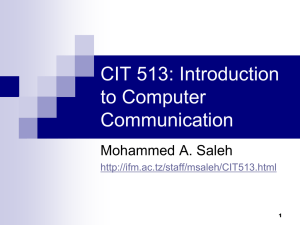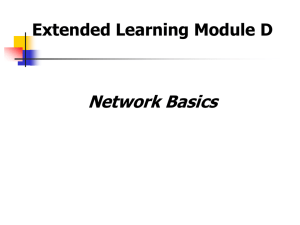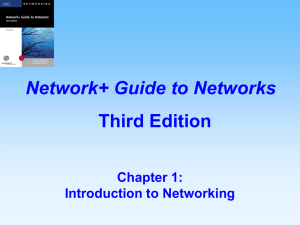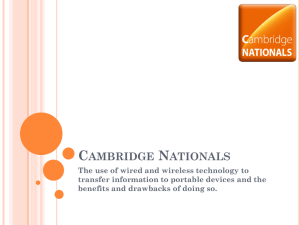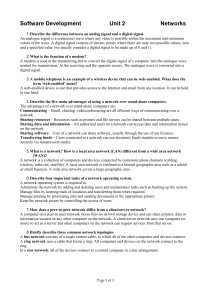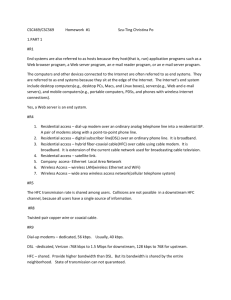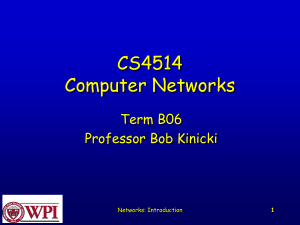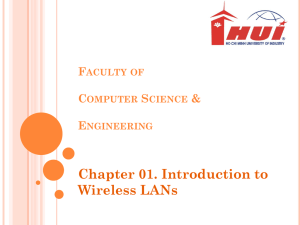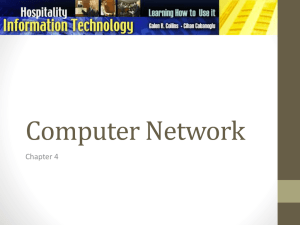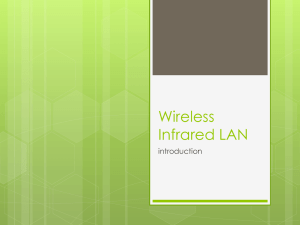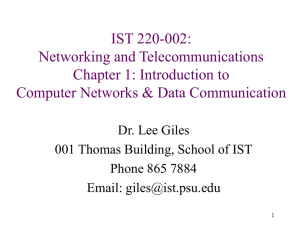lecture1
advertisement
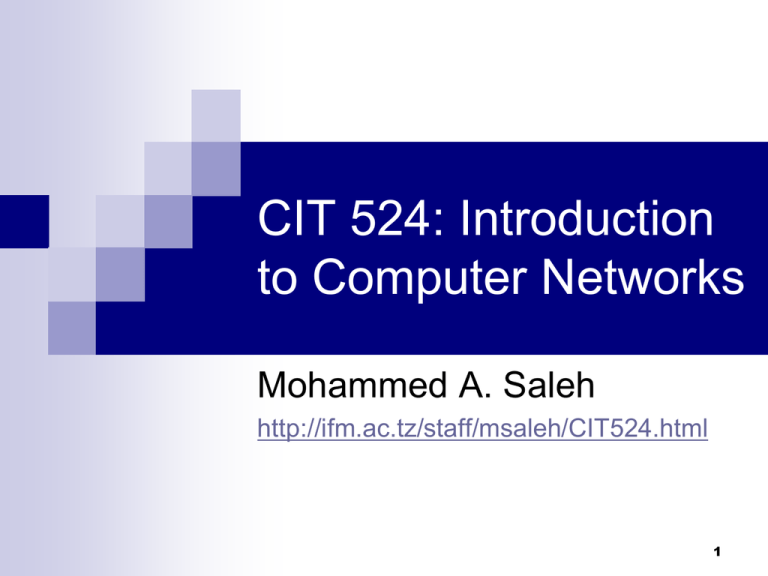
CIT 524: Introduction to Computer Networks Mohammed A. Saleh http://ifm.ac.tz/staff/msaleh/CIT524.html 1 Important Information Lecturer name: Mr. Mohammed A. S. Find out about my contact details from my personal website http://ifm.ac.tz/staff/msaleh For any questions regarding the course, you can write me an email at any time. Will try to be prompt for response. If you need to see me in my office please book an appointment by writing me an email m.saleh030@gmail.com All notes will be uploaded on the CIT 524 web page, http://ifm.ac.tz/staff/msaleh/CIT524.html A hardcopy will be submitted to the class representative 2 Basic Rules Try to attend ALL lectures Sign against your name on the register Try not to be late, if you have to be late, come in quietly. If you miss a class find out what was covered Material covered in lectures is examinable The course notes are not meant to be exhaustive, read the recommended books; Read critically, point out any errors in the lecture notes. 3 Required Readings Author Year Title Publisher Hermachandran L. 2003 Computer Communications Network Charulatha Tanenbaum A. S. 2005 Computer Networks Prentice-Hall Galo M. A. 2002 Computer Communications and Networking Technologies Pacific Grove Rowe S and Schuch 2005 Computer Networking Pearson 4 Recommended Readings Author Year Title Publisher Kurose J. F 2001 Computer Networking a top down approach Pearson Halsall 2005 Computer Networking and Internet McGraw-Hill Madhulika J. 2002 Computer Networks BPB 5 How to survive this course Materials sound simple and easy, but they are not. Do not leave everything to the exam night!. Not to copy others work!, try them by yourself. You can read the course by yourself, but the class makes the life for you easier. 6 Module Content 1. 2. 3. 4. 5. 6. Introduction to Network Concepts Local Area Networks (LANs) Wide Area Networks (WANs) Internet Basics Network Configuration and Connectivity Network Troubleshooting Basics 7 Method of Assessment Student will be assessed through CA (coursework) Two compulsory tests – Dates will be announced soon! Tutorials and Assignments – Must attend tutorials! Final examinations Coursework carries 40% Final Exams carries 60% 8 Introduction What is a Computer Network? A network is nothing more than two or more computers connected to each other so that they can exchange information, such as e-mail messages or documents, or share resources, such as disk storage or printers. These computers may be interconnected in the same building or different buildings. In most cases, this connection is made via electrical cables that carry the information in the form of electrical signals. The cables transmitting the information are commonly known as transmission media. The transmissions media are classified as wired or wireless transmission media. 9 Cont … Examples of wired transmission medias are Unshielded Twisted Pair (UTP), Coaxial Cable or Fiber Optic Cable (a) Coaxial (b) Fiber Optic (c) UTP 10 Cont … Wireless transmission medias include radio waves, infrared and Bluetooth (a) Bluetooth icon (b) Radio signals 11 Cont … When a computer is turned on and can be visible by all other computers, then that computer is said to be online. If a computer is not turned on and it is not visible by other networked computers, it is then said to be offline. 12 Why Computer Networks? Networks are all about sharing. are about sharing three things: information, resources, and applications. Sharing information: allow users to share information in several different ways. The most common way of sharing information is to share individual files. For example, two or more people can work together on a word-processing document. Sharing resource: certain computer resources, such as printers or hard drives, can be set up so that network users can share them. Sharing these resources can result in significant cost savings. For example, it is cheaper to buy a single high-speed printer with advanced features that can be shared by an entire workgroup than it is to buy separate printers for each user in the group. 13 Cont … Sharing applications: several users can work together on a single business application, For example, an accounting department may have accounting software that can be used from several computers at the same time. Other uses High reliability: All data can be copied on two or three machines, so if one of them is unavailable then other two copies could be used. Communication: A computer network can provide a powerful communication medium along widely separated employees. 14 Networks building blocks All networks, large or small, require specialized network hardware to make them work. Small networks will have less network hardware than large networks. Small or large, all networks are built from the following basic building blocks: Client computers computers that end users use to access the resources of the network. located on users’ desks. usually run a desktop version of Windows such as Windows Vista or Windows XP, along with application soft- ware such as Microsoft Office. sometimes referred to as workstations. 15 Cont … Server computers Network interface card (NIC) Computers that provide shared resources, such as disk storage and printers, as well as network services, such as e-mail and Internet access. run a specialized net- work operating system such as Windows Server 2008 or 2003, along with special software to provide network services. An interface that’s installed in a computer that enables the computer to communicate over a network. Every client and every server computer must have a NIC in order to be a part of a network. Cable Computers in a network are usually physically connected to each other using a cable 16 Cont … Switches Wireless networks Network cable usually doesn’t connect computers directly to each other Instead, each computer is connected by cable to a device known as a switch Each switch contains a certain number of ports, typically 8 or 16 computers to communicate via radio signals radio transmitters and receivers take the place of cables main advantage of wireless net- working is its flexibility main disadvantage of wireless networking is that it is inherently less secure than a cabled network. Network software As important as network hardware. Server computers typically use a special network operating system (also known as a NOS) in order to function efficiently. 17 Clients and Servers The network computer that contains the hard drives, printers, and other resources that are shared with other network computers is called a server Any computer that’s not a server is called a client. Differences between the two computers: The most powerful and expensive computers in a network are the servers The cheaper and less powerful computers in a network are the clients every user on the network shares the server’s resources. clients’ resources don’t have to be shared Most networks have more clients than servers A network with ten clients can probably get by with one server. 18 Cont … A computer is either a server or a client, and not both A server can’t become a client, nor can a client become a server This is a segregated network Any computer in the network to be a server and allowing any computer to be both server and client at the same time This is referred to as a progressive network Look at your right hand (server) and then look at your left hand (client). Don’t wash your hands until you have understood these terms! 19 Types of Computer Networks 1. 2. 3. 4. Networks are classified according to their geographical coverage and size Network classifications include: Personal Area Networks (PANs) Local Area Networks (LANs) Metropolitan Area Networks (MANs) Wide Area Networks (WANs) 20 Personal Area Networks (PANs) Introduced by the presence of wireless technologies. It is also referred to as Wireless Personal Area Networks (WPAN). WPAN refers to the technologies involved in connecting devices in very close proximity to exchange data or resources. An example of this can be seen through connecting a mobile device with a mobile device to exchange files (music, photos or documents) Connecting a laptop with a PDA. 21 Cont … Because of the close proximity of WPAN networking, short-range wireless technologies are typically used. This includes Bluetooth and Infrared A laptop sending a file to a Personal Digital Assistant (PDA). 22 Cont … Mobile devices that can form a PAN 23 Local Area Network (LAN) A network that is restricted to a single geographical location. Encompasses a relatively small area such as an office building or school The function of the LAN is to interconnect workstation computers for the purposes of sharing files and resources. It is typically high speed and cheaper to set up than a WAN 24 Cont … Local Area Network 25 Wide Area Network (WAN) A network that spans more than one geographical location often connecting separated LAN They are built so that users from one location can communicate with users from another location Many WANs are built for one organization and are private WANs are slower than LANs Often require additional and costly hardware Routers Dedicated leased line Complicated implementation procedures Example of a WAN: 26 Cont … Wide Area Network 27 Metropolitan Area Network (MAN) A network that usually spans across the city or a large campus Interconnects several local area networks It uses a high-speed cable for the interconnections between different LANs It might be owned or operated by a single organization Its geographical scope falls between a WAN and a LAN MANs provides internet connectivity for LANs in the same metropolitan area 28 Cont … 29 Network Models 1. 2. There are two basic wired network models from which to choose: Peer-to-peer network model Client/ server network model The model used for a network is determined by several factors how the network will be used how many users will be on the network budgetary considerations 30 Peer-to-peer Network Model This is a decentralized network model offering no centralized storage of data or centralized control over the sharing of files or resources. All systems on a peer-to-peer network can share the resources on their local computer as well as use resources of other systems. Advantage: They are cheaper and easier to implement than client/server networks, making them an ideal solution for environments in which budgets are a concern It does not work well with large numbers of computer systems 31 Cont … Disadvantages: As a peer-to-peer network grows, it becomes increasingly complicated to navigate and access files and resources connected to each computer because they are distributed throughout the network. The lack of centralized data storage makes it difficult to locate and back up key files Typically found in small offices or in residential settings where only a limited number of computers will be attached and only a few files and resources shared. Rule of Thumb: Have no more than 10 computers connected to a peer-to-peer network. 32 Client/ server Network Model It is the most widely implemented model and the one you are most likely to encounter when working in real-world environments. Advantages: It allows for centralized network management of all network services user management, security and backup procedures. Disadvantages: It requires technically skilled personnel to implement and manage the network Adds the cost of a dedicated server hardware and software 33 Questions
